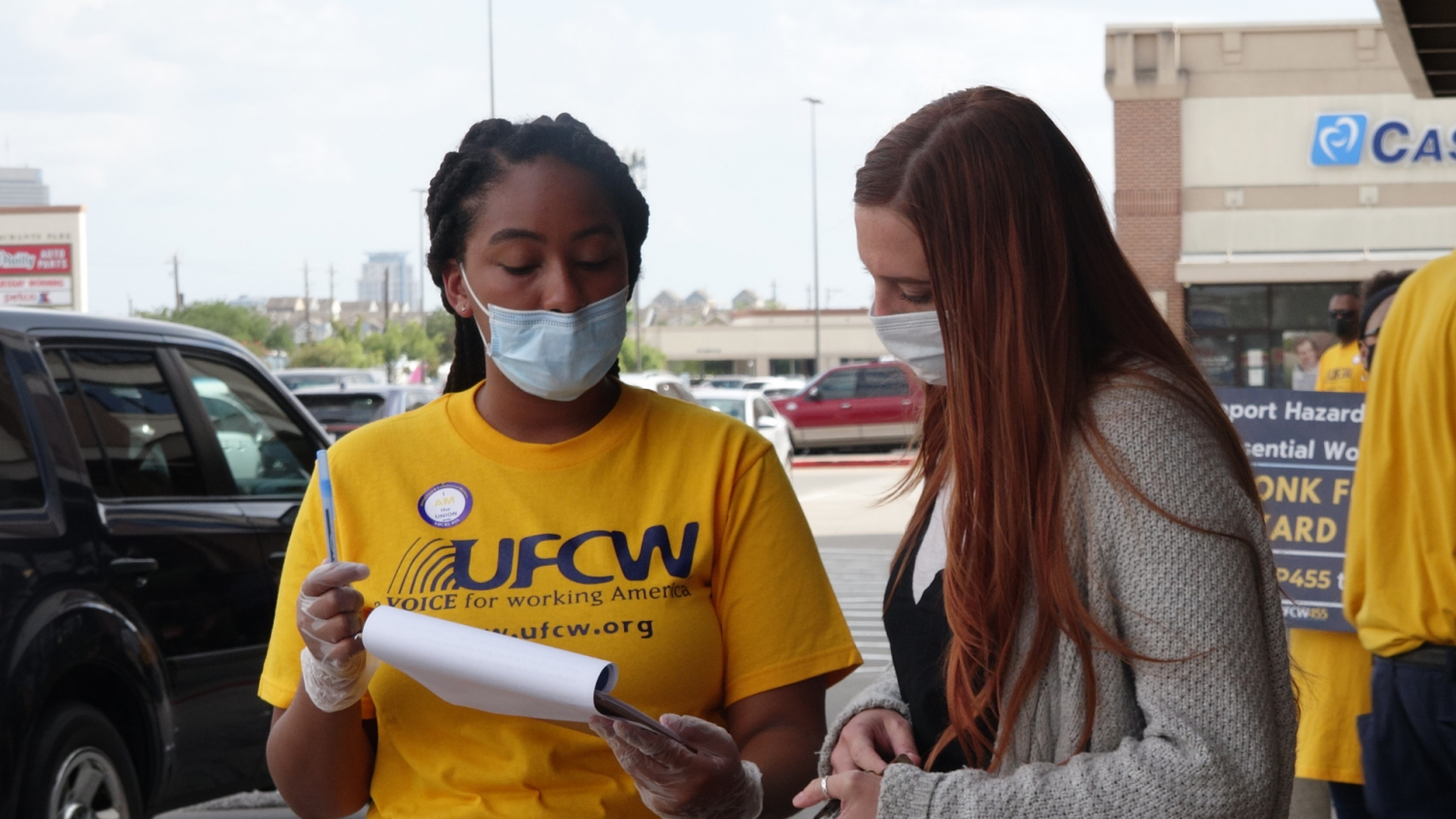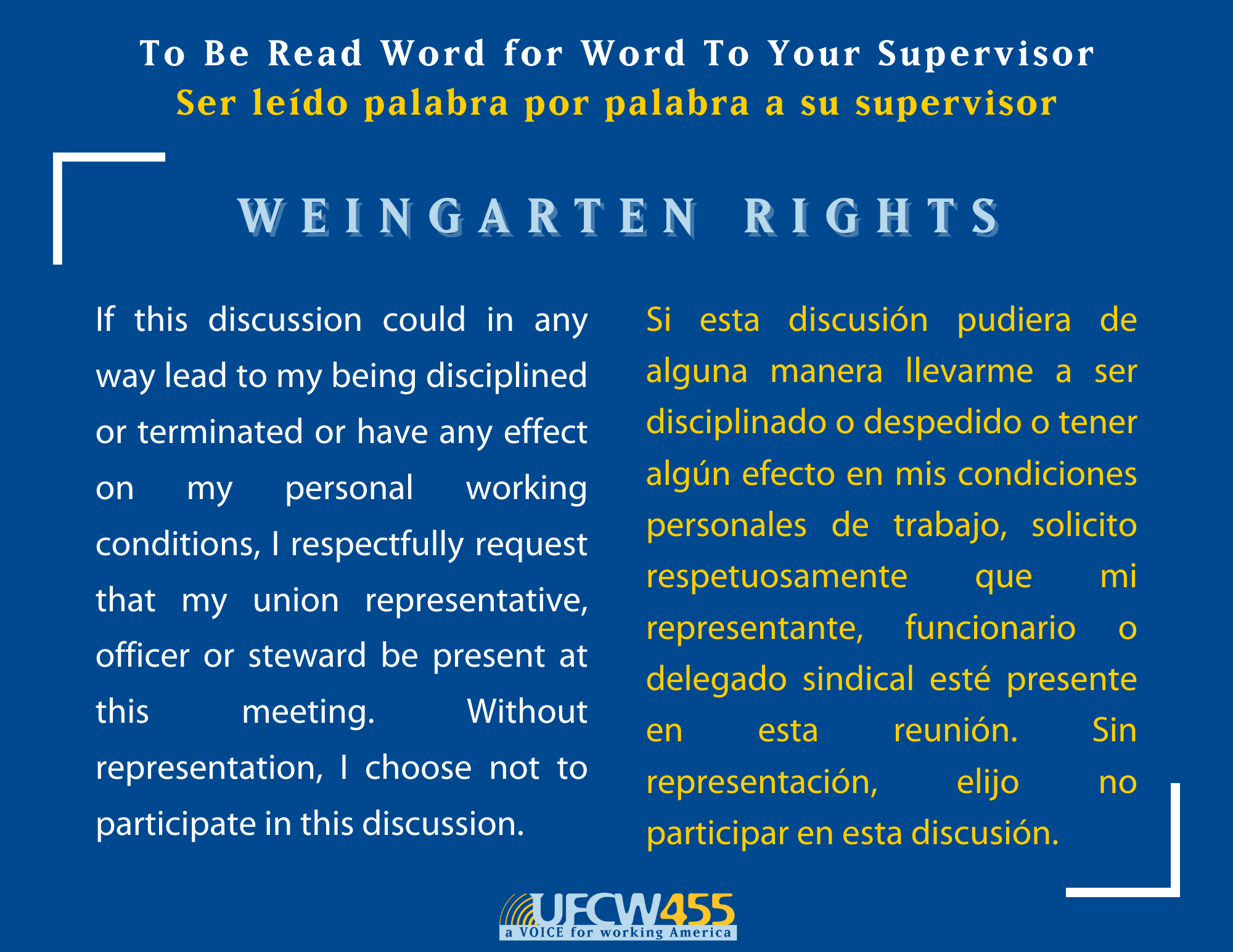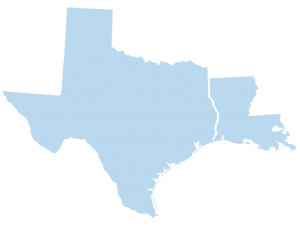Your safety and health at work is protected by the Occupational Safety and Health Administration (OSHA). This administration was created after the passing of the Occupational Safety and Health Act of 1970. OSHA Standards are rules which your employer must follow to ensure a hazard-free workplace.
Workplace Safety & Health

All workers have the right to:
- A safe workplace.
- Raise a safety or health concern with your employer or OSHA, or report a work-related injury or illness, without being retaliated against.
- Receive information and training on job hazards, including all hazardous substances in your workplace.
- Request a confidential OSHA inspection of your workplace if you believe there are unsafe or unhealthy conditions. You have the right to have a representative contact OSHA on your behalf.
- Participate (or have your representative participate) in an OSHA inspection and speak in private to the inspector.
- File a complaint with OSHA within 30 days (by phone, online or by mail) if you have been retaliated against for using your rights.
- See any OSHA citations issued to your employer.
- Request copies of your medical records, tests that measure hazards in the workplace, and the workplace injury and illness log.
Employers must:
- Provide employees a workplace free from recognized hazards. It is illegal to retaliate against an employee for using any of their rights under the law, including raising a health and safety concern with you or with OSHA, or reporting a work-related injury or illness.
- Comply with all applicable OSHA standards.
- Notify OSHA within 8 hours of a workplace fatality or within 24 hours of any work-related inpatient hospitalization, amputation, or loss of an eye.
- Provide required training to all workers in a language and vocabulary they can understand.
- Prominently display [Job Safety and Health – It’s the Law poster] in the workplace.
- Post OSHA citations at or near the place of the alleged violations.
On-Site Consultation services are available to small and medium-sized employers, without citation or penalty, through OSHA-supported consultation programs in every state.
Where can I find more information?
Call 1-800-321-OSHA (6742) or visit osha.gov/workers.
If you work under a UFCW Local 455 contract, you can also file a grievance for unsafe working conditions.
Weingarten Rights
In 1975 the United States Supreme Court, in the case of NLRB v. J. Weingarten, upheld a National Labor Relations Board decision that gave employees a right to union representation at investigatory interviews when they reasonably believe the interview may result in discipline. Employees also have the right to know before a meeting what general matter, such as work performance, dishonesty, tardiness, etc., is being investigated. However, you MUST request Union Representation! No request, no right!*
Nine times out of ten, stewards are the representatives who attend these meetings with workers. At the beginning of the meeting, this law requires the supervisor or manager to disclose all meeting topics and to give the worker a chance to ask for a representative. Workers can demand the presence of any on-duty steward. If none is available, the supervisor or manager must postpone the meeting until a steward is available. Companies may not punish workers for exercising their Weingarten rights.
We encourage all workers to exercise their Weingarten Rights
If you are called into a meeting which you feel may result in discipline, recite the words in the image below to invoke your Weingarten Rights and request union representation.
Weingarten Rules
1
The employee must make a clear request for union representation before or during the interview and the employee cannot be punished for making this request.
2
Once the employee has invoked their right to representation, the employer has 2 options:
- The employer can grant the request and delay the interview until representation arrives.
- Deny the request and end the interview.
3
If the employer denies the request for union representation, it has committed an unfair labor practice and the employee can refuse to answer any questions and the employer cannot discipline the employee for such a refusal.
*These rights do not apply if you do not have Union Representation at your workplace.
Grievance Procedure
A grievance is defined as a formal complaint, usually lodged by an employee or the union, alleging a violation of one or more terms in your union contract. The grievance procedure is the steps established in your union contract for the handling of grievances. The purpose of the grievance procedure is to enforce your contract, interpret the meaning and intent of the contract and to settle grievances in a systematic way. If you feel your contractual rights have been violated, call your Union Representative immediately.
Note: There is a time limit for filing grievances, meaning you must grieve the violation within the terms of your contract. Contact your Union Representative for a copy of your contract.
Grievance Procedure Example:

Union Activity
Sec. 7. [§ 157.] Employees shall have the right to self-organization, to form, join, or assist labor organizations, to bargain collectively through representatives of their own choosing, and to engage in other concerted activities for the purpose of collective bargaining
Sec. 8. [§ 158.] (a) [Unfair labor practices by employer] It shall be an unfair labor practice for an employer– (1) to interfere with, restrain, or coerce employees in the exercise of the rights guaranteed in section 7;
The NLRA guarantees the right of employees to organize and bargain collectively with their employers, and to engage in other protected concerted activity. Employees covered by the NLRA * are protected from certain types of employer and union misconduct. This Notice gives you general information about your rights, and about the obligations of employers and unions under the NLRA. Contact the National Labor Relations Board, the Federal agency that investigates and resolves complaints under the NLRA, using the contact information supplied below, if you have any questions about specific rights that may apply in your particular workplace.
Under the NLRA, you have the right to:
- Organize a union to negotiate with your employer concerning your wages, hours, and other terms and conditions of employment.
- Form, join or assist a union.
- Bargain collectively through representatives of employees’ own choosing for a contract with your employer setting your wages, benefits, hours, and other working conditions.
- Discuss your terms and conditions of employment or union organizing with your co-workers or a union.
- Take action with one or more co-workers to improve your working conditions by, among other means, raising work-related complaints directly with your employer or with a government agency, and seeking help from a union.
- Strike and picket, depending on the purpose or means of the strike or the picketing.
- Choose not to do any of these activities, including Joining or remaining a member of a union.
Under the NLRA, it is illegal for your employer to:
- Prohibit you from soliciting for a union during non-work time, such as before or after work or during break times; or from distributing union literature during non-work time, in non-work areas, such as parking lots or break rooms.
- Question you about your union support or activities in a manner that discourages you from engaging in that activity.
- Fire, demote, or transfer you, or reduce your hours or change your shift, or otherwise take adverse action against you, or threaten to take any of these actions, because you join or support a union, or because you engage in concerted activity for mutual aid and protection, or because you choose not to engage in any such activity.
- Threaten to close your workplace if workers choose a union to represent them.
- Promise or grant promotions, pay raises, or other benefits to discourage or encourage union support.
- Prohibit you from wearing union hats, buttons, t-shirts, and pins in the workplace except under special circumstances.
- Spy on or videotape peaceful union activities and gatherings or pretend to do so.
Where can I find more information?
Call 1-844-762-NLRB (1-844-762-6572) or visit nlrb.gov/ to learn more.
Illegal conduct will not be permitted. If you believe your rights or the rights of others have been violated, you should contact the NLRB promptly to protect your rights, generally within six months of the unlawful activity. You may inquire about possible violations without your employer or anyone else being informed of the inquiry. Charges may be filed by any person and need not be filed by the employee directly affected by the violation.
FMLA
What is FMLA leave?
The Family and Medical Leave Act (FMLA) is a federal law that provides eligible employees with job-protected leave for qualifying family and medical reasons. The U.S. Department of Labor’s Wage and Hour Division (WHD) enforces the FMLA for most employees.
Eligible employees can take up to 12 workweeks of FMLA leave in a 12-month period for:
- The birth, adoption or foster placement of a child with you,
- Your serious mental or physical health condition that makes you unable to work,
- To care for your spouse, child or parent with a serious mental or physical health condition, and
- Certain qualifying reasons related to the foreign deployment of your spouse, child or parent who is a military servicemember.
An eligible employee who is the spouse, child, parent or next of kin of a covered servicemember with a serious injury or illness may take up to 26 workweeks of FMLA leave in a single 12-month period to care for the servicemember.
You have the right to use FMLA leave in one block of time. When it is medically necessary or otherwise permitted, you may take FMLA leave intermittently in separate blocks of time, or on a reduced schedule by working less hours each day or week. Read Fact Sheet #28M(c) for more information.
FMLA leave is not paid leave, but you may choose, or be required by your employer, to use any employer-provided paid leave if your employer’s paid leave policy covers the reason for which you need FMLA leave.
Am I eligible to take FMLA leave?
You are an eligible employee if all of the following apply:
- You work for a covered employer,
- You have worked for your employer at least 12 months,
- You have at least 1,250 hours of service for your employer during the 12 months before your leave, and
- Your employer has at least 50 employees within 75 miles of your work location.
You work for a covered employer if one of the following applies:
- You work for a private employer that had at least 50 employees during at least 20 workweeks in the current or previous calendar year,
- You work for an elementary or public or private secondary school, or
- You work for a public agency, such as a local, state or federal government agency. Most federal employees are covered by Title II of the FMLA, administered by the Office of Personnel Management.
How do I request FMLA leave?
Generally, to request FMLA leave you must:
- Follow your employer’s normal policies for requesting leave,
- Give notice at least 30 days before your need for FMLA leave, or
- If advance notice is not possible, give notice as soon as possible.
You do not have to share a medical diagnosis but must provide enough information to your employer so they can determine whether the leave qualifies for FMLA protection. You must also inform your employer if FMLA leave was previously taken or approved for the same reason when requesting additional leave.
Your employer may request certification from a health care provider to verify medical leave and may request certification of a qualifying exigency.
The FMLA does not affect any federal or state law prohibiting discrimination or supersede any state or local law or collective bargaining agreement that provides greater family or medical leave rights.
State employees may be subject to certain limitations in pursuit of direct lawsuits regarding leave for their own serious health conditions. Most federal and certain congressional employees are also covered by the law but are subject to the jurisdiction of the U.S. Office of Personnel Management or Congress.
What does my employer need to do?
If you are eligible for FMLA leave, your employer must:
- Allow you to take job-protected time off work for a qualifying reason,
- Continue your group health plan coverage while you are on leave on the same basis as if you had not taken leave, and
- Allow you to return to the same job, or a virtually identical job with the same pay, benefits and other working conditions, including shift and location, at the end of your leave.
Your employer cannot interfere with your FMLA rights or threaten or punish you for exercising your rights under the law. For example, your employer cannot retaliate against you for requesting FMLA leave or cooperating with a WHD investigation.
After becoming aware that your need for leave is for a reason that may qualify under the FMLA, your employer must confirm whether you are eligible or not eligible for FMLA leave. If your employer determines that you are eligible, your employer must notify you in writing:
- About your FMLA rights and responsibilities, and
- How much of your requested leave, if any, will be FMLA-protected leave.
Where can I find more information?
Call 1-866-487-9243 or visit dol.gov/fmla to learn more.
If you believe your rights under the FMLA have been violated, you may file a complaint with WHD or file a private lawsuit against your employer in court.




